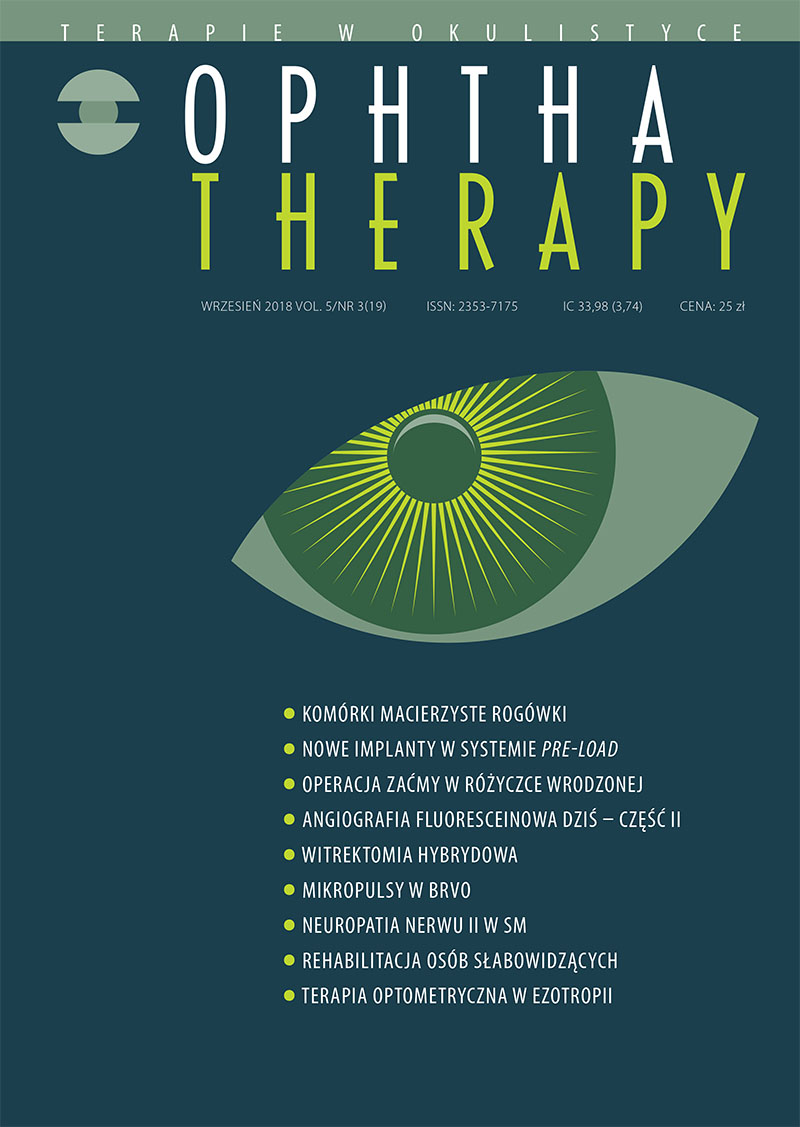Zastosowanie laseroterapii mikropulsowej w obrzęku plamki związanym z zakrzepem gałęzi żyły środkowej siatkówki
##plugins.themes.bootstrap3.article.main##
Abstrakt
Szacuje się, że liczba chorych w Polsce, którzy co roku doświadczają następstw zakrzepu gałęzi żyły środkowej siatkówki, sięga 160 tys. Część przypadków ma przebieg bezobjawowy, inne wpływają na spadek ostrości wzroku wywołany niedokrwieniem i następczym obrzękiem plamki. W potwierdzonych przypadkach zaleca się doszklistkową podaż preparatu anty-VEGF. Podprogowa laseroterapia mikropulsowa stanowi bezpieczną alternatywę we wczesnych postaciach obrzęku plamki w zakrzepie gałęzi żyły środkowej siatkówki. Najlepsze efekty terapeutyczne osiągano u pacjentów, u których czas trwania choroby nie przekraczał 6 miesięcy. U 5 spośród 7 leczonych chorych stwierdzono poprawę jakości widzenia już po 4–8 tygodniach od zabiegu. Redukcję grubości siatkówki odnotowano u 6 chorych. Bezpieczeństwo i dostępność laseroterapii mikropulsowej stanowią zachętę do jej stosowania u chorych z powikłaniami po zakrzepie gałęzi żyły środkowej siatkówki.
Pobrania
##plugins.themes.bootstrap3.article.details##

Utwór dostępny jest na licencji Creative Commons Uznanie autorstwa – Użycie niekomercyjne – Bez utworów zależnych 4.0 Międzynarodowe.
Copyright: © Medical Education sp. z o.o. License allowing third parties to copy and redistribute the material in any medium or format and to remix, transform, and build upon the material, provided the original work is properly cited and states its license.
Address reprint requests to: Medical Education, Marcin Kuźma (marcin.kuzma@mededu.pl)
Bibliografia
2. Genentech based of population-based studies, the Beaver Dam Eye Study. 2000, 2008.
3. Argon laser photocoagulation for macular edema in branch vein occlusion. The Branch Vein Occlusion Study Group. Am J Ophthalmol. 1984; 98(3): 271-82.
4. Roider J. Laser treatment of retinal diseases by subthreshold laser effects. Semin Ophthalmol. 1999; 14(1): 19-26.
5. Inagaki K, Ohkoshi K, Ohde S et al. Subthreshold Micropulse Photocoagulation for Persistent Macular Edema Secondary to Branch Retinal Vein Occlusion including Best-Corrected Visual Acuity Greater Than 20/40. J Ophthalmol. 2014, 2014: 251257.
6. Lavinsky D, Sramek C, Wang J et al. Subvisible retinal laser therapy: titration algorithm and tissue response. Retina. 2014; 34(1): 87-97.
7. Hayreh S, Zimmerman M. Branch retinal vein occlusion: natural history of visual outcome. JAMA Ophthalmol. 2014; 132(1): 13-22.
8. McIntosh RL, Rogers SL, Lim L et al. Natural History of Central Retinal Vein Occlusion: An Evidence-Based Systematic Review. Ophthalmology. 2010; 117: 1113-23.
9. Chatziralli IP, Jaulim A, Peponis VG et al. Branch retinal vein occlusion: treatment modalities: an update of the literature. Semin Ophthalmol. 2014; 29(2): 85-107.
10. Campochiaro PA, Heier JS, Feiner L et al. Ranibizumab for macular edema following branch retinal vein occlusion: six-month primary end point results of a phase III study. Ophthalmology. 2010: 117(6): 1102-12.
11. Hayreh SS, Rubenstein L, Podhajsky P. Argon laser scatter photocoagulation in treatment of branch retinal vein occlusion. A prospective clinical trial. Ophthalmologica. 1993; 206: 1-14.
12. Inagaki K, Shuo T, Katakura K et al. Sublethal Photothermal Stimulation with a Micropulse Laser Induces Heat Shock Protein Expression in ARPE-19 Cells. J Ophthalmic. 2015; 2015: 729792.
13. Scholz P, Altay L, Fauser S. A Review of Subthreshold Micropulse Laser for Treatment of Macular Disorders. Adv Ther. 2017; 34(7): 1528-55.
14. Parodi MB, Iacono P, Bandello F. Subthreshold grid laser versus intravitreal bevacizumab as second-line therapy for macular edema in branch retinal vein occlusion recurring after conventional grid laser treatment. Graefes Arch Clin Exp Ophthalmol. 2015; 253(10): 1647-51.

